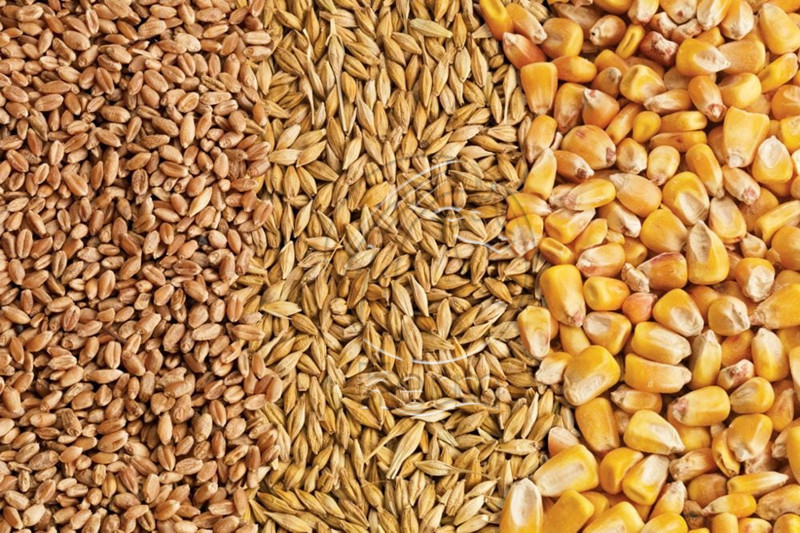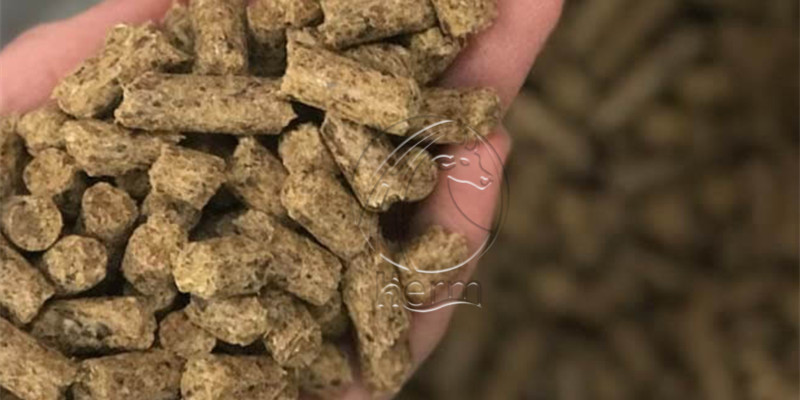
The main raw materials of feed are mainly divided into the following types:
1. Feed ingredients that contain a lot of starch
These feeds are mainly composed of grains, seeds, and roots or tubers containing a large amount of starch. For example, all kinds of grains, potatoes, wheat, barley, beans, etc. These feeds mainly provide energy through polysaccharides and contain little protein. They are suitable for ruminants, poultry, and pigs, but feeds containing too much starch are not suitable for horses. After being processed by a pellet feed-making machine, their starch is converted into nutrients and absorbed by animals.

2. Oily-containing feed ingredients
These feeds are composed of oily seeds (rape, soybean, sunflower, peanut, cottonseed), etc. The energy of these feeds mainly comes from lipids, so their energy density is higher than that of feeds containing starch. The protein content of these feeds is also relatively low. Because these oils also have industrial uses, the popularity of such feed is not high.
The residue left after industrial oil pressing still contains quite a high oil content. Such residue can also be used as feed, especially for ruminants, and is also widely used. For example, adding rapeseed oil residue to the chicken feed machine to make chicken feed can improve the egg-laying rate.
3. Sugary-containing feed ingredients
These feeds are mainly straw feed or pellet feed based on "sweet sorghum straw". The sugar content of sweet sorghum straw is 18% - 23%, and the animal palatability is very good.

4. Protein-containing feed materials
These feeds are mainly plant protein feeds based on the protein mulberry. The plant protein of protein mulberry reaches 28% - 36% and is rich in 18 kinds of amino acids. It is the best raw material to replace plant protein.
5. Green feed ingredients
In these feeds, the whole plant is fed, such as grass, corn, grain, etc. These feeds contain a lot of carbohydrates, and the nutrition is very miscellaneous. For example, grass mainly contains carbohydrates, 15% to 25% protein, while corn contains more starch (about 20% to 40%) and less than 10% protein. The green feed can be fed fresh or stored after drying. They are more suitable for ruminants, horses, and waterfowl. You don't usually feed pigs. The green feed preserved after fermentation is called silage.

6. Other feed ingredients
In addition to the above-mentioned feeds, there are many other kinds of feeds, which can be directly from nature (such as the fish meal) or industrial replicas (such as rice bran, distiller grains, leftovers, etc.). Different livestock use different feeds, but these feeds are especially suitable for ruminants.
Function of conditioner
Conditioner is widely used in animal feed machinery. It mainly consists of the following four points
1. Curing treatment. The ability of most animals to digest starch is very low, but they can digest cooked starch to a large extent. The conditioner can greatly increase the gelatinization degree of starch under the action of hydrothermal. At the same time, it also promotes the thermal denaturation of protein in the material, and the denatured protein is easy to be hydrolyzed by enzyme, to improve the digestion and utilization rate of pellet feed.
2. Sterilization treatment. Most pathogenic bacteria, such as Escherichia coli and Salmonella, are not heat-resistant. Conditioning materials at a certain temperature with a conditioner can kill these bacteria and ensure a hygienic level of feed. Compared with drug disease prevention, this method of sterilizing materials through a conditioner has the advantages of low cost, no pollution, no drug residue, side effects.

3. The conditioning equipment can significantly improve the water-resistance of pellet feed. During the conditioning process, through the hydrothermal action of steam, the viscous components in the material, gelatinized starch, and modified protein can give full play to the role of binder and effectively bond other components around. Under the extrusion action of the molding roller, the particles are more closely combined Thus, the pellet feed becomes denser, the appearance is smooth, it is not easy to be eroded by water in the feeding process, and the stability of water is increased.

4. The conditioning equipment can improve the granulation of materials, increase the output, save the energy consumption of granulation, and improve the service life of the die and roller of the granulator. Through quenching and tempering, the material can be softened and more plastic. In the extrusion process with the die hole wall, the die inner wall, and the surface of the pressure roller, the friction is reduced, which avoids the transformation of a large amount of mechanical energy into heat energy in the granulation process, and slows down the wear of the die and the pressure roller.
Henan Herm Machinery Co., Ltd was established in 2010 and has been devoted to the research and development of Feed Mill Machinery ever since. With more than 10 years of experience, Herm® has become a leading manufacturer and supplier of animal feed machines and complete animal feed production lines, cattle feed plants, poultry feed plants, animal feed pellet production lines, etc. It always endeavored to improve the quality of products and aims to meet the new requirements of the international market.
If You Are Ready to Start a Feed Pellet Plant Business, please contact us for the feed mill machine. We Can Provide Professional Design and Comprehensive Guidance According to Your Needs. Get in touch with us now!
Welcome Contact Us!
Henan Herm Machinery Co., Ltd
Email: info@hermmachinery.com
Phone/Whatsapp: 86-18037508651
0
0









Leave a Comment
You should login or register to leave a comment
No Comments / 91 Views